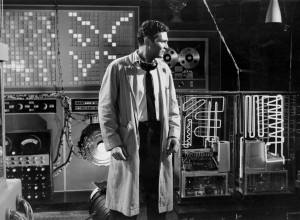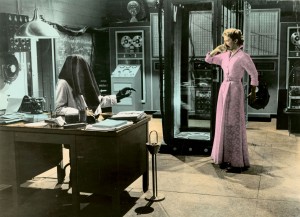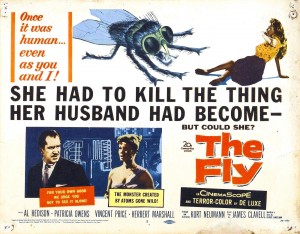“On The Fly” Part Three: Destination
(The third of a four-part essay. Previous part.)
 Ominous fears seem right at home during the Second Red Scare, when the term “McCarthyism” was coined. With the launch of Sputnik the same year “The Fly” was published, it would be easy to read the story as a Cold War allegory, like other stories prophesying the collapse of capitalism. That collapse has yet to happen, and still the story has currency. There must be something else in the mix giving the story ongoing relevance.
Ominous fears seem right at home during the Second Red Scare, when the term “McCarthyism” was coined. With the launch of Sputnik the same year “The Fly” was published, it would be easy to read the story as a Cold War allegory, like other stories prophesying the collapse of capitalism. That collapse has yet to happen, and still the story has currency. There must be something else in the mix giving the story ongoing relevance.
The 1950s was much more than a time of escalating political tensions. It was also the decade in which commercial jet aviation really took off (pardon the pun), allowing writers like Langelaan to propose that the world would soon be transformed by another revolution in transport. The desirability of this transformation is lightly sketched in “The Fly”, but that it would be radical is emphasized.
This development, combined with the dawning of the age of television, brought that which had seem purely external, even alien, within easy reach—an issue explored in the kind of stories that use d-mat to engage with strangeness beyond the borders of the known.
The decade also saw a steep rise in nuclear tests, with the French joining the Americans, Russians and British in detonating their weapons all over the world (it is significant, perhaps, in terms of the story’s international impact that “The Fly” is set in France). President Truman’s authorization to develop the much more powerful Hydrogen bomb and a greater understanding of the effects of radiation sickness and fall-out led to spreading concerns about physical mutation and the destruction of society. Technology’s shadow seemed to grow a little darker, not this time thanks to the work of amoral scientists or Nazis, but to the unintended consequences of allowing science to aspire to apparently worthy goals. Innocent mistakes led to disasters such as the Minamata Disease crisis in Japan and the Windscale fire, the worst nuclear accident in U.K. history. Even life-saving developments such as open heart surgery came with images of blood and mutilation that were not easily erased. The invisible hand of technology steadily invaded homes and bodies, threatening to twist and sicken the general populace in ways never conceived before.
 “The Fly” succeeds in part because it is this fear that Langelaan is evoking, with a pay-off that is beyond the merely physical. As in J. T. McIntosh’s “Five into Four”, he proposes that technology, in this case d-mat, is a profound threat to the very essence of ourselves, if we are careless. François’s seemingly simple fear of the telephone is a springboard allowing the reader to leap over the obvious anxieties of the invasion of personal and political spaces, the pollution of the body, and the collapse of society as we know it, straight to the dissolution of the self.
“The Fly” succeeds in part because it is this fear that Langelaan is evoking, with a pay-off that is beyond the merely physical. As in J. T. McIntosh’s “Five into Four”, he proposes that technology, in this case d-mat, is a profound threat to the very essence of ourselves, if we are careless. François’s seemingly simple fear of the telephone is a springboard allowing the reader to leap over the obvious anxieties of the invasion of personal and political spaces, the pollution of the body, and the collapse of society as we know it, straight to the dissolution of the self.
This is revealed in one of André’s final type-written messages to his wife:
“I AM ALIVE ALL RIGHT, BUT I AM ALREADY NO LONGER A MAN. AS TO MY BRAIN OR INTELLIGENCE, IT MAY DISAPPEAR AT ANY MOMENT. AS IT IS, IT IS NO LONGER INTACT, AND THERE CAN BE NO SOUL WITHOUT INTELLIGENCE . . . AND YOU KNOW THAT!”
With this appeal to commonsense, André reveals that he has been gifted with much more than just the arm and head of a fly. He has been invaded by the fly’s instincts, to the point where he fears losing his humanity completely. Rather than live with the consequences of his error or seek help from others with similar expertise to him, he opts for complete obliteration, no matter the cost to those around him.
 This extreme response to loss of self is taken further in the 1959 movie. André’s psychological transformation is depicted by showing him struggle with his new man-fly nature, actively intercepting his monstrous limb as it seeks to attack Helene. He buzzes and twitches threateningly. His appetites are primal, and his table manners repulsive. “Andre” has been disintegrated and what remains of “Andre” on reintegration is clearly struggling to retain a civilized, human demeanor—a human self, in essence. The addition of fly and then cat to the man thus externalizes an already present fear of invasion and corruption by technology, through telephone wires or over André’s machine.
This extreme response to loss of self is taken further in the 1959 movie. André’s psychological transformation is depicted by showing him struggle with his new man-fly nature, actively intercepting his monstrous limb as it seeks to attack Helene. He buzzes and twitches threateningly. His appetites are primal, and his table manners repulsive. “Andre” has been disintegrated and what remains of “Andre” on reintegration is clearly struggling to retain a civilized, human demeanor—a human self, in essence. The addition of fly and then cat to the man thus externalizes an already present fear of invasion and corruption by technology, through telephone wires or over André’s machine.
Technology is not dangerous in and of itself, but there are risks in any endeavor, and these risks are magnified when dangerous elements are added to the mix—flies in the ointment, if you like. When the ointment is likened to modern technologies like television, it is easy to see why this story found such a prominent home, and had currency far greater than many similar stories of that period.
(Next in Part Four: Redux)
